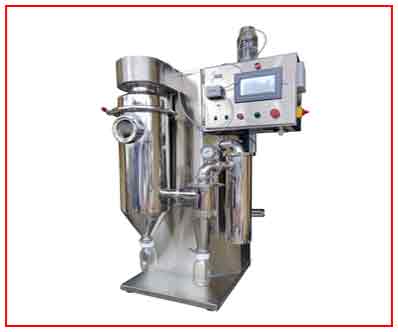Spray Drying solutions for R & D and Production
Mumbai, Maharashtra
Monday to Saturday

Spray drying is a well-known method of particle manufacturing that entails the transformation of a fluid substance into dried particles by utilising a gaseous hot drying medium. The lab spray dryer process has obvious advantages for the creation of medical devices. Indeed, the manufacture of microspheres and microcapsules for drug delivery systems is relatively frequent. This blog discusses the many stages of the spray-drying mechanism, including atomization, droplet to particle conversion, and collecting.
With the advancement of modern science and technology, numerous sectors have increased their requirements for product raw materials, most notably for powder materials manufacturing. A laboratory spray dryer is now one of the most widely utilised processes for drying material powders, as it has the potential to reduce the powder product's thermal effect significantly. There are other types of spray dryers available. However, the majority of universities and research institutions opt for the Lab spray dryer. Its features include high efficiency, labor savings, minimal procedures, relatively basic equipment construction, a small footprint, convenience, and a high-quality product.
Some common lab spray dryers manufactured are centrifugal spray dryers and two-fluid spray dryers (airflow spray dryers). Centrifugal spray drying has the following characteristics: rapid drying speed, difficulty cleaning, high degree of atomization, relatively large equipment area, and high cost. Some of the two-fluid spray drying characteristics are small size, beautiful appearance, not easily blocked, and precise control.
Spray dryers manufacturers design machine that includes all components required for the spray drying process and features temperature, liquid sample flow, drying airflow, and compressor pressure control. The unit is equipped with a compressor.
Spray drying comprises three main processes: liquid atomisation, evaporation, and product collection/ separation. A vertical drying chamber is sprayed with the material to be dried. Simultaneously, a significant volume of hot air is blown into the chamber, evaporating the sample's liquid content. After the drying process is complete, the hot air and solids are separated in a glass cyclone.
Working Principle
A peristaltic pump pumps the liquid containing solid components through the two-fluid nozzle, and compressed air sprays the solution into small droplets into the drying chamber. The little mist droplets in the heated air have a large specific surface area. They are capable of conducting enough heat to swiftly sublime the surface water vapor into dry solid particles. The cyclone separator separates the solid particles from the exhaust gas and directs them to the collection bottle. The exhaust gas is released directly to the atmosphere or through an air filter system. Among them, the dual-fluid nozzle has its own through the needle, and by regulating the through needle's frequency, the nozzle may be kept clear of obstructions. The spray particles' average particle size can be changed by adjusting the compressed airflow.
Applications
Industrial spray dryers manufacturers in Mumbai produce numerous spray dryers, each with its own set of unique features tailored to satisfy a range of spray drying requirements. Spray drying is a process that can be used on food products (e.g., starch, molasses, rice protein, corn syrup, honey, and dairy), chemicals, and pharmaceuticals. Dryers are composed of several fundamental components: a feed pump, an atomizer or nozzles, an air heater, an air disperser, a drying chamber, powder recovery systems, and process control systems.
Laboratory spray dryer are particularly effective for drying solutions, slurries, and pastes that cannot be mechanically dewatered. They are also a suitable process for particles that are heat sensitive and cannot be subjected to high temperatures for extended periods or include ultrafine particles that agglomerate and fuse if dried in any state other than dilution. Due to the highly brief residence time in the dryer's hot zone, spray drying is particularly well suited for heat-sensitive items.
Takeaway
Currently, laboratory spray dryers are utilised in various applications, and their applications are growing increasingly diverse. With society and technology advancing at a breakneck pace, the Lab spray dryer should be augmented and enhanced by new technologies. This will not only affect energy conservation and environmental protection but will also significantly improve the quality of the lab spray dryer, which will be the research direction for future lab spray dryer improvements and upgrades.
Are you looking for spray dryer manufacturers in India?
Get in touch with us!

Head of Innovation
Lorem Ipsum is simply dummy text of the printing and typesetting industry. Benenatis mauris. Vestibulum ante ipsum primis in industry, logistics, finance, business orci ultrices venenatis mauris.
Marketing
92%
Marketing
82%